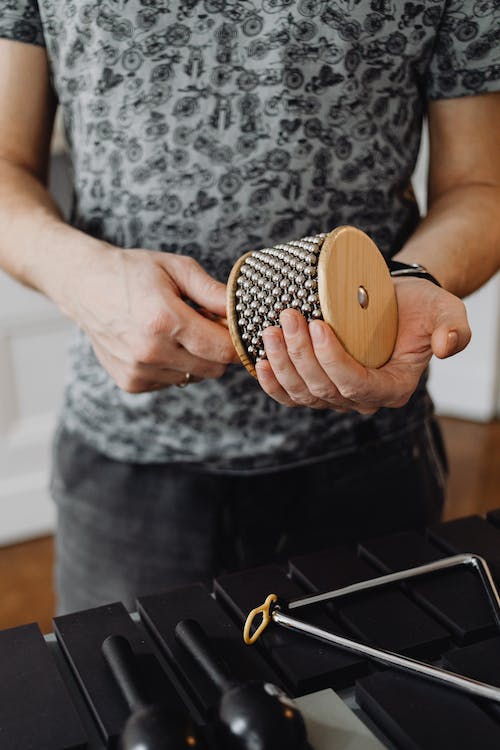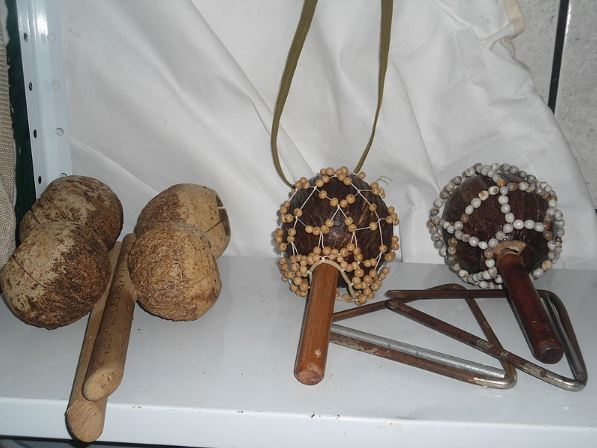Cabasa is a percussion instrument similar to the shekere, a western African instrument. It is a popular hand percussion classified as an idiophone, a sub-family of percussions. The cabasa is constructed with a steel ball chain that is wrapped around its wide cylindrical head.Its head is attached to a long narrow stick that is usually made out of plastic or wood. Initially, the cabasa, also known as agbe, is a gourd which originated in Africa.Back then, it wasconstructed from a dried oval-shaped gourd with netted-beads on the outer surface.Aside from this version, there are several more variations of the cabasa, more particularly in Latin music. Another example of these is the cabaça, which is similar to the cabasa when it comes to its pear-shaped gourd covered with beads. It is also used in Latin-American dance as well as in Latin jazz music.
Nowadays, the most common commercially available cabasas are similar to the cabaça but were typically made out of wood or steel.The metal version of the cabasa was created and credited to the founder of Latin Percussion Company, Martin Cohen. This company, also known as LP, was established in New York City in the year 1964. Despite his difficulty in establishing the company, he was able to expand it and became the leading innovator of percussion instruments in his area. The Latin Percussion specializes in making ethnic instrumentsthat are engineered and manufactured to withstand the rigors of use in a drum set. With this kind of engineering, their instrument offers great and consistent durability. Interestingly, the re-engineering also allows the instruments to change sound and adjust volume, in accordance with the player’s preferences, without losing the quality of its sound.
Along with their percussion instruments were their durable cabasa, which they called afuche-cabasa. This cabasa, as well as its cousins, the Cuban chekereand Brazilianxequere, are commonly used in Latin jazz and bossa nova pieces. Unlike the cabasa, its other versions are still widely made out of dried gourds. Additionally, as opposed to membranophone instruments, such as drums, the cabasa does not produce sound through vibrating membrane attached to the instrument’s frame.
The cabasa sounds like a rattle, although the cabasa is more versatile than the other rattle-type instruments like the maracas. The wooden cabasa bridges the gap between the sounds of percussion instruments and drum instruments. However, the cabasa is not quite as bright as the cymbals or the tambourines, although it emphasizes an upper-register of pitch that can be easily recognized in a band mix.
To produce a mellow sound, a wooden flangewas attached to it rather than textures steel beads. Moreover, for a brighter and more cutting sound, the performer could use a model that comes with a stainless-steel cylinder. When it comes to its pitch, the smaller the cabasa, the higher its pitch, while the larger ones are more resonant because of their larger cylinders. Cabasa can also be made out of plastic, although it cannot produce the full sound that is required in a Latin percussion ensemble. Cabasas made out of plastic is only useful for beginners who are trying to be familiarized or trying their first set of instruments.
In playing the cabasa, the performer must hold the handle on their dominant hand and shake it in a rhythmic pattern similar to the rattle. Meanwhile, the player’s non-dominant hand must be used in hovering over the metal loop beads that are attached to its cylindrical head. Tapping and releasing the metal loop beads can be done to create a more complex timbre and rhythms. Furthermore, the cabasa can also be accompanied by a foot pedal. It can either be supported by attaching the cabasa to a foot pedal for a drum kit or by a foot pedal that is specially designed for the cabasa.
Aside from being a musical instrument that is used in several genres of music, it is also frequently used in therapies. Patients who have neurological and physical disabilities that require minimal hand movementuses the cabasa for their music therapy.The therapist uses the music produced by this instrument in building neurological connections between hearing the sound and hand movement.


